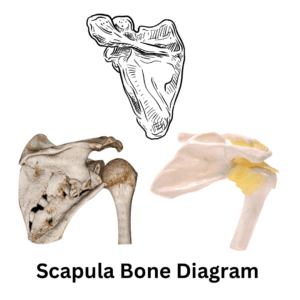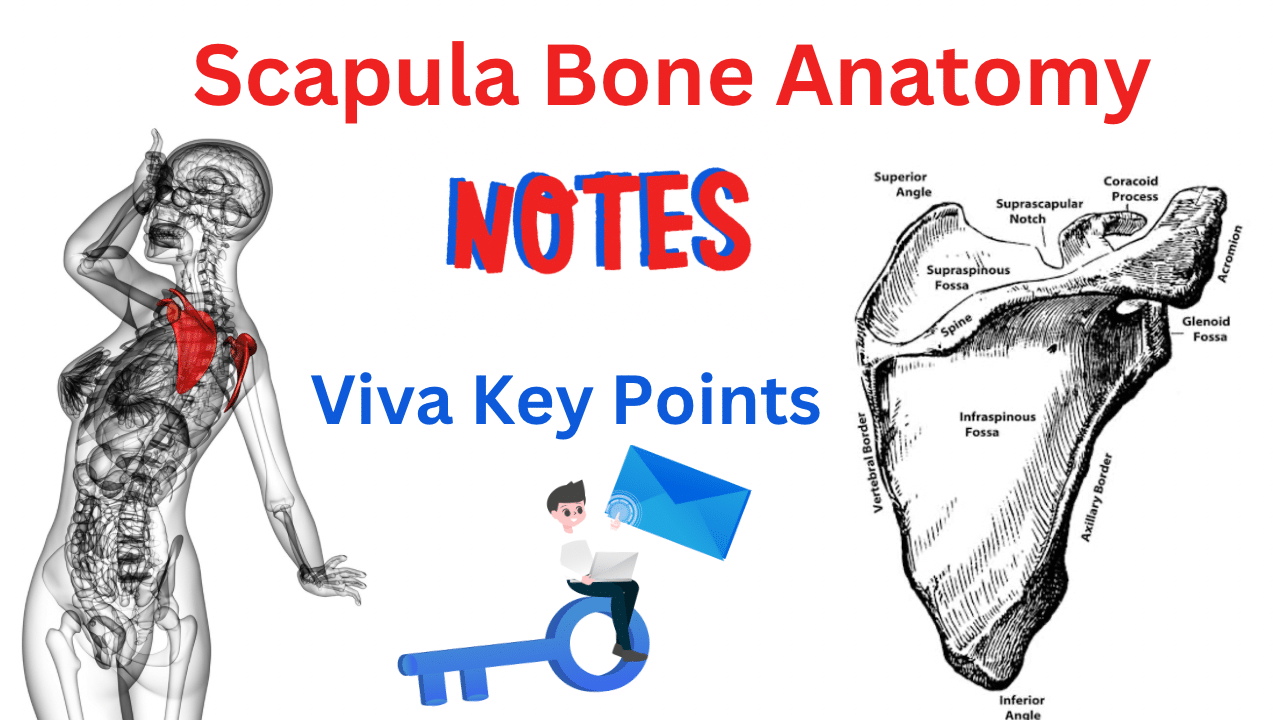Unlocking Shoulder Power: The Hidden Role of Your Scapula – scapula bone also known as the shoulder blade, is a large triangular-shaped bone located on the posterior (back) aspect of the shoulder.
It plays a very important role in the movement and stability of the shoulder joint.

Let’s explore the anatomy of scapula bone :
Body:
The scapula’s main part is the body, which is flat and thin.
It has two surfaces: the costal (anterior) surface facing the ribcage and the dorsal (posterior) surface facing away from the ribcage.
spine of scapula :
The spine of the scapula is a prominent ridge that runs diagonally across the dorsal surface.
It divides the scapula into unequal portions, known as the supraspinous fossa (above the spine) and infraspinous fossa (below the spine).
Muscles and tendons attach to the spine to provide movement and stability to the shoulder joint.
Acromion Process:
The acromion process is a flattened extension of the scapula that forms the highest point of the shoulder.
It articulates with the clavicle (collarbone) to form the acromioclavicular joint.
Glenoid Cavity:
The glenoid cavity is too shallow, which has a concave depression on the lateral aspect of the scapula.
It articulates with the head of the humerus (upper arm bone) to form the glenohumeral joint, also known as the shoulder joint.
Coracoid Process:
The coracoid process is a curved, beak-like projection located on the anterior surface of the scapula, just below the clavicle.
It provides attachment points for various muscles, ligaments, and tendons, including the coracoclavicular ligament and the short head of the biceps brachii muscle.
Superior and Inferior Borders:
The scapula has two borders—the superior border, also known as the superior margin, runs horizontally across the superior aspect of the bone, and the inferior border, or the medial margin, runs along the lower aspect of the bone.
These borders provide attachment sites for muscles and help define the shape of the scapula.
Medial and Lateral Angles:
The medial angle, or superior angle, is the superior-most point where the superior and medial borders of the scapula meet.
The lateral angle, or inferior angle, is the inferior-most point where the medial and lateral borders of the scapula meet.
Subscapular Fossa:
The subscapular fossa is the concave area on the costal surface of the scapula.
It is covered by the subscapularis muscle, which assists in internal rotation of the arm.
These are the primary anatomical features of the scapula.
It is important to note that the scapula interacts with various muscles, tendons, ligaments and other bones to enable shoulder movement and stability.
Impotant key points for Viva ( Unlocking Shoulder Power: The Hidden Role of Your Scapula )
When preparing for a viva on scapula anatomy, it is important to have a clear understanding of the key points.
Here are some important aspects to consider:
Identification (Scapula Bone Anatomy):
Be able to identify the scapula on an anatomical diagram or model. Familiarize yourself with its shape, orientation, and major anatomical landmarks.
Borders and Angles (Scapula Bone Anatomy):
Understand the superior, medial, and lateral borders of the scapula, as well as the medial and lateral angles.
Be able to locate and describe these borders and angles accurately.
Surfaces:
The scapula has two surfaces—the costal (anterior) surface facing the ribcage and the dorsal (posterior) surface facing away from the ribcage.
Know the major features and structures associated with each surface.
spine of scapula and Fossae :
Study the spine of the scapula, which divides it into the supraspinous fossa (above the spine) and infraspinous fossa (below the spine).
Understand the attachments and functions of the muscles related to these areas.
Acromion Process:
Learn about the acromion process, its location, and its articulation with the clavicle to form the acromioclavicular joint.
Understand the role of the acromion process in providing attachment for muscles and ligaments.
Glenoid Cavity:
Be familiar with the glenoid cavity, its location, and its role as the articulation point for the head of the humerus to form the shoulder joint.
Understand the importance of the glenoid labrum in enhancing the stability of this joint.
Coracoid Process:
Study the coracoid process and its attachments to various muscles, ligaments, and tendons.
Be aware of its position below the clavicle and its significance in shoulder movement and stabilization.
scapular muscles anatomy :
Understand the attachment points for important muscles associated with the scapula, such as the supraspinatus, infraspinatus, subscapularis, deltoid, and trapezius muscles.
Know their actions and functions in relation to the scapula.
Clinical Relevance:
Consider clinical aspects related to scapula anatomy, such as common injuries (e.g., scapular fractures, dislocations) and associated clinical presentations.
Understand how the scapula interacts with other structures in the shoulder region.
scapula function Function and Movement:
Have a good understanding of the role of the scapula in shoulder movement and stability.
Be prepared to explain the actions of different muscles in conjunction with the scapula during various movements of the upper limb.
scapula bone in hindi – watch below video

2 thoughts on “Unlocking Shoulder Power: The Hidden Role of Your Scapula”
Comments are closed.